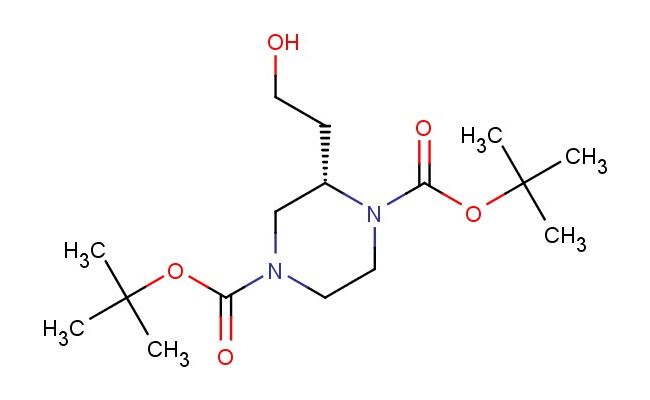(S)-di-tert-butyl 2-(2-hydroxyethyl)piperazine-1,4-dicarboxylate
$200.00
CAS No.: 660862-48-6
Catalog No.: 192807
Purity: 95%
MF: C16H30N2O5
MW: 330.425
Storage: 2-8 degree Celsius
SMILES: OCC[C@@H]1N(CCN(C1)C(=O)OC(C)(C)C)C(=O)OC(C)(C)C
Catalog No.: 192807
Purity: 95%
MF: C16H30N2O5
MW: 330.425
Storage: 2-8 degree Celsius
SMILES: OCC[C@@H]1N(CCN(C1)C(=O)OC(C)(C)C)C(=O)OC(C)(C)C
CAS NO.: 660862-48-6; (S)-di-tert-butyl 2-(2-hydroxyethyl)piperazine-1,4-dicarboxylate. PROPERTIES: This hydroxyethyl-substituted piperazine dicarboxylate has molecular formula C18H33N2O5. It appears as a white crystalline powder. The (S)-di-tert-butyl 2-(2-hydroxyethyl)piperazine-1,4-dicarboxylate demonstrates limited water solubility but good solubility in common organic solvents like methanol and ethyl acetate. Its melting point ranges between 90-95°C, and it has a molecular weight of approximately 357.49 g/mol. When handling, care should be taken to avoid skin contact and use of proper respiratory protection. Storage should be in a tightly sealed container at room temperature, protected from light and moisture. The compound is sensitive to strong acids and may hydrolyze to the corresponding carboxylic acids upon exposure to aqueous conditions. In case of spillage, absorb with inert material and dispose of in accordance with local regulations. APPLICATIONS: The (S)-di-tert-butyl 2-(2-hydroxyethyl)piperazine-1,4-dicarboxylate serves as a valuable intermediate in the synthesis of serotonin receptor antagonists for psychiatric disorders where the piperazine ring provides essential hydrogen bonding interactions with receptor subtypes (as detailed in medicinal chemistry literature). The hydroxyethyl group forms additional hydrogen bonds with receptor residues. Additionally, the compound functions as a building block in the preparation of polymeric materials with specific thermal properties, useful in high-temperature applications with glass transition temperatures exceeding 150°C as described in polymer chemistry journals. The ester groups can be further functionalized through hydrolysis or amidation reactions to produce various derivatives for chemical research applications.
Reviews
Write Your Own Review






